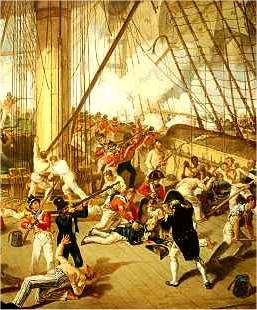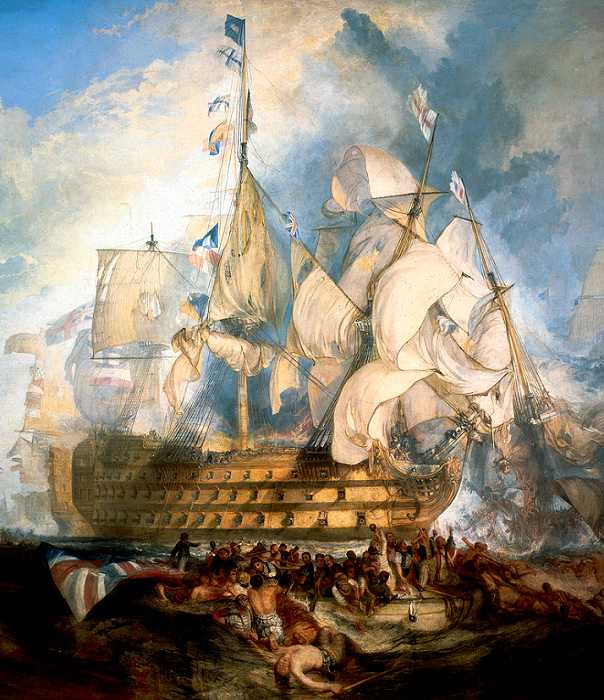In the summer of 1801, the British government decided to make an effort to destroy the flotilla Napoleon was creating off Boulogne. The Admiralty appointed Lord Nelson to be second-in-command of the Channel Fleet under Admiral Sir Hyde Parker. Nelson arrived in Deal on the evening of July 29, 1801.
It seems Nelson did not care greatly for Deal. The town had divided loyalties. Around Middle Street a whole community of smugglers lived in the tiny interconnecting passages and alleys: Silver Street, Golden Street, Dolphin Street, Farrier Street and Brewer Street, among others.
 |
 |
|
Detail from "The Fall
of Nelson" by Denis Dighton (1792-1827)
|
Detail from "The Battle of Trafalgar" by William Turner (1755-1851) |
The houses had cellars with street-level openings protected by retractable grids, and barrels of brandy and French wines slipped very easily through those holes to safe and hidden storage. You can still see the openings today. The more orthodox seafarers and fishermen often fought with the smugglers, so Deal had an ambiguous nature of which nelson would have been aware.
After the Battle of Copenhagen (2 April 1801) Nelson had suffered a serious inflammation of the lungs, so in Deal he was feeling run down and depressed. Nelson called Deal ‘the coldest place in England’
The Admiral set up his shore headquarters in the Three Kings hotel (now the Royal) and invited his brother William and family, and the Hamiltons, to come and stay at the hotel. Not rating its food highly, he wrote that fortunately one could pay for rooms only, and that they would dine elsewhere. He hoped that they ‘would not be disturbed by the sound of the surf’
On August 3 he writes, “As I understood from Mr Lawrence, the Naval Storekeeper at Deal, that 12 or 14 flat-bottomed boats would be ready to put in the water the latter end of this week, I wish very much that directions may be given to fit 8 of them with brass 8-inch howitzers and the remainder with 12-pounder carronades.”
Nelson was now off Boulogne, where he had gone on August 1 with a Captain Fyers of the Artillery, to consult as to the practicability of reaching the French ships by shell fire from the bomb -ketches. Next day the ships were sent in but although they shelled the French craft for some time, they succeeded in sinking only 5 to 10 flats and a brig. Fyers was so badly wounded in the engagement that he had to be sent back to Deal.
“Oh how I hate to be stared at”
From Boulogne, Nelson proceeded to Margate Roads to visit his ships. Here the Mayor of Sandwich came aboard. Writing to Lady Hamilton, Nelson says “they came on board to present me with the freedom of that ancient town, and requested me to dine with them. I put them off for the moment, but they would not be let off. Therefore this business, dreadful to me, stands over and I shall be attacked again when I get to the Downs. But I will not dine there if I can get off. Oh! How I hate to be stared at.” Nelson never did dine at Sandwich.
Nelson returned to the Downs to arrange for the attack on Boulogne. He was suffering from a severe chill and continually recurring sea-sickness. His command too, was distasteful to him and he wrote on 13 August. “This Boat warfare is not exactly congenial to my feelings, and I find I get laughed at for my puny mode of warfare. I am very sick. No one knows of my ideas except Captain Owen, who has long been stationed here under Admiral Lutwidge, and Captains Bedford and Parker.”
The attack on Boulogne
Nelson’s plan was to organise the armed boats into four divisions, under the command of Captains Somerville, Parker, Cotgarve and Jones, and send them into Boulogne to attack the ships there.
The boats were sent in at 11.30 on the night of August 15, but in the darkness they lost touch, one division entirely failing to reach the enemy. Parker’s division was the first to arrive, and it bore the brunt of the attack. Of a total of 44 killed and 128 wounded, 21 and 42 respectively belonged to Parker’s division. Among the wounded apart from Parker, were Lieutenant Langford, Nelson’s aide-de-camp, and Midshipmen Gore and Bristow.
The killed and wounded were landed at Deal on 17 August, Parker and Langford being conveyed to a lodging in Middle Street (reported to be number 73 to be nursed, whilst the others were taken to the Naval Hospital.
At first it seemed Parker would recover. Lady Hamilton visited him regularly and when not attending him and Langford, went for rides in a small carriage in the country behind the town. A hilltop between Walmer and Deal is known locally as ‘Lady Hamilton’s Seat’ and offers a wide view of the Downs and the Goodwin Sands.
Parker’s condition declined steadily and eventually, to Nelson’s great sorrow, he died on 26 September 1801.
The Kentish Chronicle reported:
Captain Parker, after enduring the most excruciating torture for some time past, with the greatest fortitude, expired yesterday morning about nine o’clock; and was this day at noon interred in our Chapel burying ground with all possible military honours. The body was removed from his late lodgings, at five o’clock this morning, to the Kings buildings, where every mark of attention and respect that the shortness of the time would allow, was paid to his memory by George Lawrance, esq, the Naval Officer at this port, who caused two storehouses in the Dockyard to be cleared out, and hung around with ships’ colours. At twelve o’clock precisely the procession began, and as soon as the corpse was interred, three vollies were fired , when the whole (procession) retired in inverted order from the melancholy scene. Lord Nelson seemed to be particularly affected at the unhappy fate of his gallant friend.
Parker’s funeral took place in St George’s, a church planned originally in 1706 by the town’s Mayor Thomas Powell, with the support of Admiral Sir Cloudesley Shovell, to be convenient to the Dockyard, so that sailors and fishermen would not have to walk all the way to St Leonard’s in Upper Deal.
By Nelson’s orders all ships in the Downs flew their pennants at half-mast with a minute gun being sounded from HMS Amazon and the shore alternatively from midday. To this sombre background the Military Escort, provided by the Derbyshire Regiment, marched with arms reversed and a military band ‘with drums muffled’ and tied with crape, playing the ‘Dead March’ at the head of the procession. According to local tradition, during the committal in the churchyard Nelson leant against an oak-tree and wept. He also ordered a fine white stone tomb to be erected to Parker’s memory with an engraved inscription. These can still be seen, though both tomb and inscription are badly worn. The churchyard is almost a military cemetery, for several hundred other sailors and Marines of the Napoleonic Wars are buried here.
Parker’s death added very much to Nelson’s depression. After the departure of his relatives and the Hamiltons, he wrote to Lady Hamilton: “When I reflect on the many happy scenes we have passed together, the being separated is terrible... And to make one worse, the fate of poor Parker; but God’s Will be done…”
After the failure of the Boulogne raid, Nelson began to plan another, but he received Admiralty instructions that no more attacks should take place. That summer and autumn of 1801 at Deal had been a trying time for Nelson, but it was the prelude to one of the happiest periods of his life.
While at Deal he had arranged to buy ‘the farm’ at Merton in Surrey. By 23 October, with Lord St Vincent’s permission (First Lord of the Admiralty) he had left Deal for the last time and had arrived at ‘Paradise Merton’
The British government was about to sign the proposed Armistice, which on 25 March 1802 was finally ratified as the Peace of Amiens. Nelson was unhappy about the peace, because he felt rightly that it could not last, and that it had been secured at the price of unreasonable concessions to the enemy.
1803
By May 1803 war was again raging between England and France. Preparations for continuing the struggle immediately sprang up in Deal. On the evening of May 7th at about 10 0 clock, a body of foot and horse soldiers, accompanied by officers and sailors of the Minerva and Amelia, two frigates stationed in the Downs, paraded the town. They pressed all able-bodied men they found in the streets, and even entered houses in search of recruits. The captured men where then taken to the Naval Yard and paraded for inspection. Some were liberated, and the remainder sent on board the frigates. Steps were again taken to organise the boatmen, and when Pitt came down to Walmer Castle in the autumn he consented to hold a review of them.
On September 15th a fleet of 35 luggers, some armed with eighteen pounders and others with 12 pounders, launched from Deal beach, and proceeding to Walmer, anchored in line just off shore from a point opposite the Great Bulwark (i.e. opposite Walmer Lodge) along past Walmer Castle and some way to the south of it. At noon the southernmost lugger fired her gun as a salute to the flag flying at Walmer Castle and to Pitt, who stood on the ramparts, accompanied by Lady Hester Stanhope and Lord Mahon. The salute was taken up by each lugger in succession until the whole had saluted, and then Pitt and his friends embarked amid the cheers of the assembled multitude, on board a Deal lugger steered by Thomas Canney, Warden of the Pilots. For an hour and a half they sailed along the line of boats and in and out amongst them, until each boat’s crew had received due attention, when they landed at the Castle for refreshments, after which the whole scene was re-enacted.
The Emperor sets his sight across the channel
Meanwhile Bonaparte crowned himself emperor, and began to prepare for an invasion of southern England, setting up camps in the north of France. But during 1805, Pitt began to build yet another coalition in Europe, gaining the support of Austria and Russia. On the other hand, Spain joined the French side after a squadron of British frigates captured her treasure fleet from America, and gave her an excuse for conflict.
1805
Nelson’s last battle
At sea, the blockade of Brest had been resumed soon after the outbreak of war, and Nelson was sent to blockade Toulon. The French fleet there, commanded by Villeneuve, escaped and caused Nelson to search the Mediterranean and West Indies for it. Villeneuve made for the West Indies and then doubled back towards the English Channel. He was halted off Cape Finisterre by a British squadron under Admiral Calder. The resulting action was indecisive but it forced Villeneuve to retreat to Ferrol and then Cadiz., where he joined with the Spanish fleet and was blockaded by Nelson.
In October 1805, Villeneuve was goaded by Napoleon into leaving Cadiz and offering battle. Though he had thirty-three ships-of-the-line against Nelson’s twenty-seven, the French and Spanish were so demoralised by recent British successes that they had no expectation of victory. Seventeen French and Spanish ships were captured, though most of these were lost in the storm which followed the battle. A few weeks later, four of the surviving ships were also captured, making the British victory complete. But one the greatest naval characters in British history did not live to tell the tale: Nelson perished at The Battle of Trafalgar.
Sources:
Viscount Nelson Defence against Invasion compiled by David G. Jephcott
Laker’s History of Deal
©2006 “DEAL today” magazine